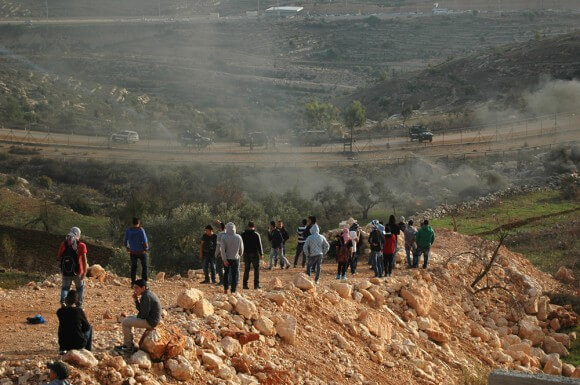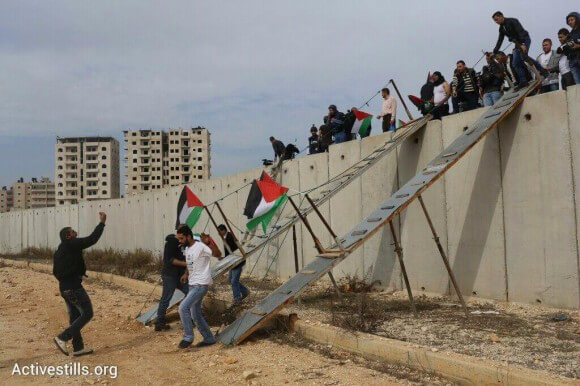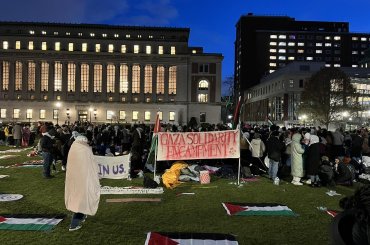On Friday Palestinian protesters crossed Israel’s separation wall by Qalandia checkpoint, the artery from the West Bank to Jerusalem, demonstrating to gain access to the city that has been enveloped in unrest over the past three weeks. Using makeshift ladders, tens of protesters walked over the barrier, but Israeli police prevented them from entering Jerusalem. Another protest demanding the right to enter the city was held at the nearby checkpoint of Hizma.
Yet after an hour of parading and stone throwing in Qalandia, while the Israeli military fired tear gas and live rounds, injuring one youth with a bullet in his leg, the flag bearers packed up their belongings. “There’s no army here, so I’m going to Ofer,” said one youth as he twirled a slingshot. In turn, Israeli soldiers retreated into the checkpoint. A group of demonstrators traveled by shared taxi to nearby Beitunya. Word had spread that a larger clash was taking place, with more daring protesters.
Mid-afternoon in Beitunya, Palestinians lobbed two Molotov cocktails at an Israeli army jeep parked outside Ofer prison. Some 200 youths cheered at the sight of the fire. They were scattered across agricultural terraces that overlook an Israeli settler highway that divides the West Bank from East Jerusalem. The highway is built on land that was confiscated from Beitunya village.
“Jerusalem is here, it is not away from us,” said Ahmad Nasser, 27, a medic who was watching the clash from higher ground. Nasser pointed to the settlement beyond the army vehicles, indicating Pisgat Ze’ev, which stands between the West Bank and the Palestinian neighborhoods of East Jerusalem. Without it, and an army road and fence that line the bypass, Nasser said the walk from Beitunya to Jerusalem takes ten minutes.
“In Qalandia it’s not that strong. It finished fast so people came to Ofer because it’s special to be in Ofer,” continued Nasser. “The prisoners are for sure watching us,” he said, “If they don’t see us, than they hear us. When they hear the army shooting they know that there are people standing in front of the prison. So it gives them some hope that people are still moving, doing things outside.”


Nasser lives a short walk from the nexus of the clash line in Beitunya. His youth was spent “between two army tanks,” during the second Intifada. At that time he and his family were trapped in their home surrounded by army vehicles. Now in adulthood, the Israeli army is also a daily reality for Nasser. Because his home is so close to the prison, often he sees soldiers walking on his street, arresting youngsters at one of Beitunya’s regular protests. The presence of military only commits Nasser to his work as a medic. He said he’s not afraid of being injured, but he does fear not being able to treat someone who has been wounded.
During the summer war in Gaza there was a flashpoint of dissidence when over 30,000 marched at Qalandia. Since that July day, protests at the checkpoint have been a few hundred persons. But they are frequent, once or twice a week, and breaching the separation wall marks an escalation.
During the summer protest Nasser was shot through the leg with a live round. The injury did not stop him from performing his medical duties, though.
“I put some gauze in my leg, I cleaned it, I covered it and then I asked my friend to give me an injection. That’s it. And, I continued working, I didn’t stop,” said Nasser. After his own shooting, Nasser transported 40 injured Palestinians to a hospital in Ramallah, on duty until 2 am.
As with many protests in the West Bank, at Ofer there is a routine. “This is what the soldiers do every time and in a few moments they will start climbing up and they will start shooting live ammunition,” he said.
But Nasser continued that even with the scant numbers, hundreds instead of thousands of protesters in marches that took place throughout the West Bank on Friday–including Hebron and Bethlehem–he still finds inspiration that a larger movement that could re-connect the West Bank to Jerusalem is on the horizon. “For me,” he said, “I prefer it more than ten protests in the West Bank, because those youth here,” he said pointing down the valley to the demonstrators standing ground under arcing tear gas canisters, “they are between 12 and 13 [years old], and they are ready to die for Jerusalem, for their lands, and for their brothers in jail—in Ofer.”
“One day you will see the youth there,” mused Nasser as a protesters approached him asking to borrow his gas masks, “walking forward to Jerusalem from here.”
Attacks on Israelis and an assassination attempt against a Temple Mount activist have yielded what Prime Minister Benjamin Netanyahu called an “iron fist” crackdown in the Arab-Palestinian neighborhoods of East Jerusalem. Arrests and clashes are nightly. On Thursday 27 Palestinians were taken to jail and an 11-year old was critically injured with a rubber “sponge” bullet. And as of last week Jerusalemites now are faced with a series of draconian laws that are said to quell the unrest, including punitive home demolitions and up to 20 years in jail for stone throwing regardless of age.
Yet while turmoil had blanketed Jerusalem with clashes continuing into today in Issawiya where the army prolonged its one week blockade of the main entrance to the neighborhood, Netanyahu agreed on Thursday to remove age restrictions for Muslim worshippers entering al-Aqsa mosque in hopes of settling protests. The move came after he met with Secretary of State John Kerry earlier that same day in Jordan on de-escalation measures for Jerusalem.



Bravo to those youths of the West Bank; they’re the start of a true resistance. This week, Marwan Barghouti from his jail cell called on the Palestinians to take up an armed resistance to the occupation and got 10 days in solitary for his outburst.
Today, Israel lifted the age restriction on male prayers at al-Aqsa. It’s too little and too late; the Palestinians have had it with being told by their leaders to take it lying down.
And the media will ignore it, as they’ll ignore Israel’s violent response to a non-violent demonstration.
And the ‘liberal Zionists’ will turn around and wag their fingers, saying ”Oh gosh, you know. If only the Palestinians would adopt non-violent resistance, they would have my support”.
Scaling that wall might just be an effective form of protest. The comparisons with the Berlin Wall are so obvious. And if anyone gets shot…
The first photo by Allison of the youths crossing the wall and the last one of the protesters on a hill overlooking the Israeli soldiers on the road below reminded me of the moving mad rush of Palestinians down the hill towards the fence and the Israeli soldiers at Maroun al-Ras on Nakba Day in May 2011:
https://www.youtube.com/watch?v=SqtlZFVGC_0
Now that is chutzpah. Good chutzpah.